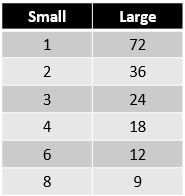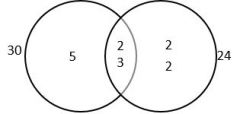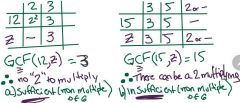![]()
![]()
![]()
Use LEFT and RIGHT arrow keys to navigate between flashcards;
Use UP and DOWN arrow keys to flip the card;
H to show hint;
A reads text to speech;
27 Cards in this Set
- Front
- Back
|
Number Properties – Divisibility & Primes advanced What is the characteristic of the 25 primes until 100? or All prime numbers except 2 and 5 end in... |
1, 3, 7 or 9 since numbers ending in 0, 2, 4, 6 or 8 are multiples of 2 and numbers ending in 0 or 5 are multiples of 5 |
|
|
Verifying the primality |

divide n by all integers numbers smaller than √n
|
|
|
Divisibility and Primes - Prime Factorization Use prime factorization to... |
|
|
|
Divisibility and Primes - Factors and Multiples How many factors does 72 have? |

|
|

If a number has a prime factorization, how do you calculate the total # of factors? |

|
|
|
If a number has a prime factorization, how do you sum the total # of factors? |

|
|
|
Divisibility and Primes - Factors and Multiples
How many total factors does the number 2,000 have? |

First apply prime factorization and apply the prior formula So, 2,000 has 5.4 = 20 total factors |
|
|
Simplifying exponential expressions What is the largest prime factor of 4²¹ + 4²² + 4²³? |
4²¹ + 4²² + 4²³ = 4²¹(1 + 4 + 16) = 4²¹.(21) = 4²¹(3.7) THEREFORE, he largest prime factor of 4²¹ + 4²¹ + 4²³ is 7 |
|
|
Divisibility and Primes - The prime box |
3.7 = 21, 3.11 = 33, 7.11 = 77, 3.7.11 = 231.
If a number has the primes 2, 3 and 7 in its prime box, this number will also be divisible by any combination of them. |
|
|
all prime numbers above 3 are of the form... |
6n−1 or 6n+1 Because all other numbers are divisible by 2 or 3. |
|
|
Divisibility and Primes - Finding GCF and LCM using Venn Diagrams What are the steps to find the GCM and the LCM using Venn Diagram? |
|
|
|
Divisibility and Primes - Finding GCF and LCM using Venn Diagrams Find GCF and LCM for 24 and 30 |

GCF = 2 . 3 = 6
LCM = 2 . 2 . 2 . 3 . 5 = 120 If 2 numbers have no primes in common, their GCF is 1 |
|
|
How to calculate the LCM and the GCF of a fraction |

|
|
|
Simplifying exponential expressions When expressions with the same base are linked by a sum, you cannot simplify but you can factor the expression 7² + 7³ =? |
7².(1 + 7) = 49*8
|
|
|
Advanced Problems - Divisibility and GCF and LCM techniques Finding GCF and LCM of 3 or more numbers |
(1) calculate the prime factors of each integer
(2) create a column for each prime factor found and a row for each integer Raise each prime to a power, which is the number of times it appeared on that integer |
|
|
Advanced Problems - Divisibility and GCF and LCM techniques Find the GCF and LCM of 100, 140 and 250 |

Prime factors: 100 2,2,5,5. 140 2,2,5,7. 250 2,5,5,5
GCF is the smallest count in any column: 2¹ . 5¹ = 10 |
|
|
Advanced Problems - Divisibility and GCF and LCM techniques Three important properties of GCF and LCM (two #'s) |
(1) (GCF of m and n) * (LCM of m and n) = m.n (2) GCF or m and n cannot be larger than the difference of m and n (3) Consecutive multiples of n have a GCF of n. Example: the GCF of 84 and 88 is 4. |
|
|
Advanced Problems - Divisibility and GCF and LCM techniques Is z divisible by 6? (1) the GCF of z and 12 is 3 (2) the GCF of z and 15 is 15 |

|
|
|
Advanced Problems - Divisibility and GCF and LCM techniques If the LCM of a and 12 is 36, what are the possible values for a? |

So, "a" could be: 3.3 = 9, OR 2.3.3 = 18, OR 2.2.3.3 = 36
|
|
|
Advanced Problems - Counting total factors I don’t need to consider how many times each prime is repeated in a number or in a product to.. |
...know how many different prime factors it has.
|
|
|
Advanced Problems - Counting total factors I need to count repeated prime factors to... |
...know the length of a number or how many total prime factors it has.
|
|
|
Advanced Problems - Counting total factors If you are asked “how many total factors” |
use the technique showed before
|
|
|
Advanced Problems - Perfect squares, cubes, etc
All perfect squares have an odd number of... |
total factors
|
|
|
Advanced Problems - Perfect squares, cubes, etc 100 = 10 × 10 = 2^2 × 5^2 What does mean a factor multiplies by itself to give the number ? |
1, 2, 4, 5, 10, 20, 25, 50, 100
1 × 100 = 100; 2 × 50 = 100; 4 × 25 = 100; 5 × 20 = 100 10 is in the middle. It has no companion with which it could multiply and give 100! This means, we have a factor which multiplies by itself to give the number. Hence the number N (=100 here) must be a perfect square! |
|
|
Advanced Problems - Perfect squares, cubes, etc What are the three properties of perfect squares? 100 |
We can make only (2 + 1) = 3 odd factors
3 × 2 = 6 even factors.
P.S. 18 has 6 factors (1, 2, 3, 6, 9, 18). Their sum is 39, an odd number but 18 is not a perfect square. |
|
|
Advanced Problems - Factorials and divisibility N! is multiple of all integers from... 10! + 11! Is a multiple of any integer from... |
...1 to N ...1 to 10, as both terms include every integer from 1 to 10. |
|
|
if k³ is divisible by 240, what is k’s least possible value?
|
The prime factorization of k³ results AT LEAST on 2,2,2,2,3,5.
So, since k³ = k.k.k, each k has at least two 2’s, one 3 and one 5. So, k’s least possible value is 2.2.3.5 = 60 |

